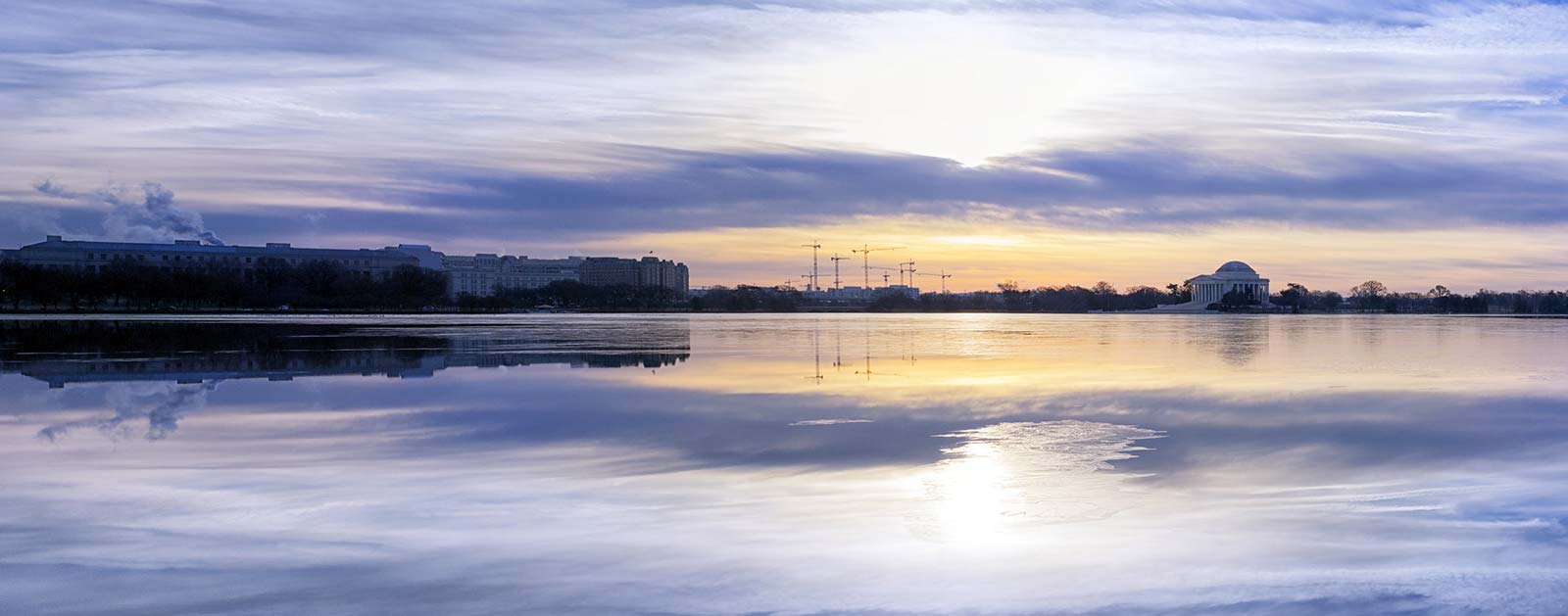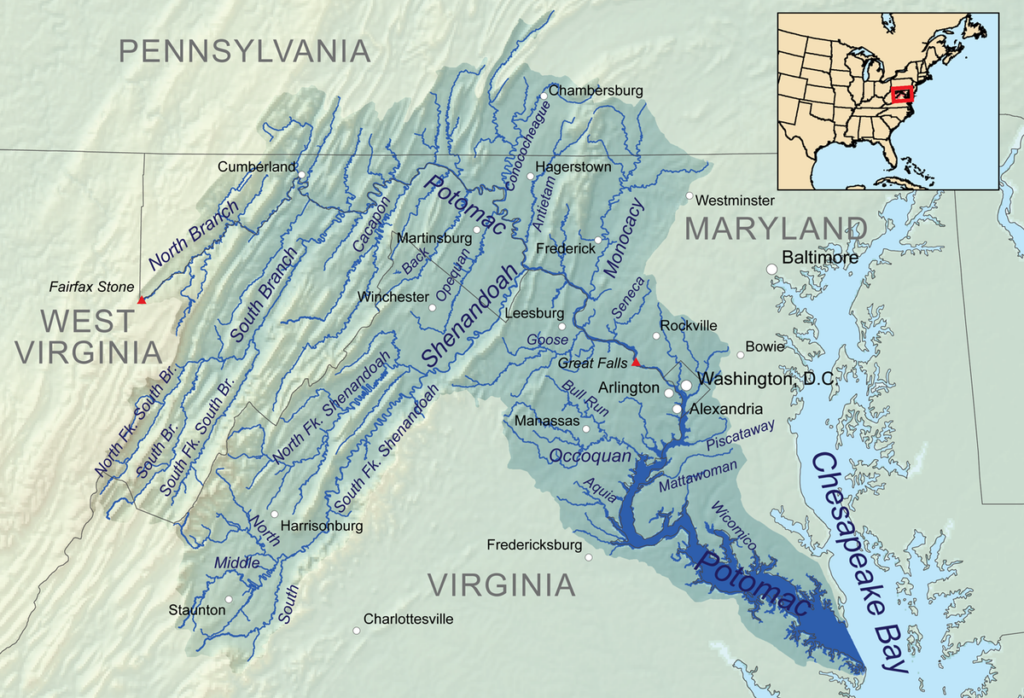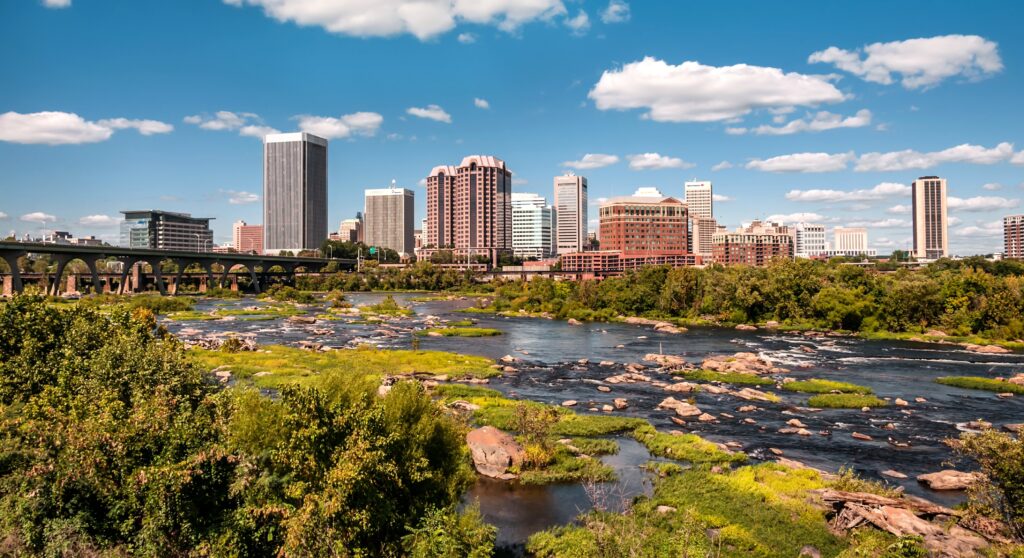Potomac River
America’s River

George Washington could have built his home anywhere on the Eastern Seaboard. He chose the Potomac River, forever identifying it as the “Nation’s River.”
But even more significant than Washington’s riverside estate at Mt. Vernon and the Federal City bearing his name just upstream, the Potomac’s first calling is its service as the southern headwaters of the Chesapeake Bay. The cultural and historic lifeblood of our nation’s capital remains a living, pulsing force providing sustenance and vitality to the most important estuary in the East.
Only the Susquehanna River emptying into the Chesapeake’s northernmost point at Havre de Grace, MD, qualifies as a larger tributary than the Potomac. Originating in the Allegheny Mountains of West Virginia and drawing from the hills of Virginia and Maryland, which are collectively recognized as the Potomac River Highlands, the river offers a diversity of culture, history, and wildlife as it channels the border between those states and Washington, DC, on its 380-mile run to the Tidewater at Point Lookout, MD.
Along the way, it picks up water from key tributaries including the Anacostia, Shenandoah, and Monocacy rivers, and connects people to nature. Its watershed of 14,670 square miles is nearly 60 percent forest, qualifying it as one of the most forested in the country. It provides critical habitat for wildlife and multiple species of fish while offering the nation’s capital a place to play.
Fishing, paddling, hiking, boating, wildlife watching and riverside sightseeing are just a few of the popular pastimes for the millions who visit the vast river basin. More than four million people come to the historic Chesapeake & Ohio Canal National Historic Park annually, with the thundering Great Falls of the Potomac Gorge as one of the park’s biggest draws. From fly fishing shops and whitewater kayakers to commercial fishermen, marinas, and restaurants, everyone benefits from access to clean river water.
President Bill Clinton designated the Potomac as an American Heritage River in 1998, which, for five years, allowed communities along the rivers to access federal resources to help revitalize their rivers, riverfronts, and local economies.
Did You know?
The largest flow ever recorded on the Potomac at Washington, DC, was 425,000 cubic feet per second in March, 1936. The lowest flow ever recorded at the same location was 600 cfs in September, 1966.
After assassinating President Lincoln in April of 1865, John Wilkes Booth attempted to escape by crossing the Potomac by boat. Due to poor navigation, he landed downstream in Blossom Point, MD.
In 1930, Congress deemed the Great Falls area of the river a national park and the National Park Service took over its operations in 1966.
President Bill Clinton designated the Potomac as an American Heritage River in 1998.
What states does the river cross?
Maryland, Pennsylvania, Virginia, Washington DC, West Virginia

The Backstory
President Lyndon B. Johnson had a different perspective back in 1965, when he called the Potomac “a national disgrace” because of the polluted water that filled the channel. Wetlands and streams had been bulldozed, filled in, and destroyed. The river that provides 90 percent of the drinking water to the Washington, DC, metro area was overrun with algae and trash.

Let's Stay in touch!
We’re hard at work in the Mid-Atlantic for rivers and clean water. Sign up to get the most important news affecting your water and rivers delivered right to your inbox.
The headwaters of the river may have suffered even more. Originating in the heart of America’s coal country, the fragile streams making their way east to the Atlantic fell as casualties to the impacts of mining development and deforestation along their way to the farmlands of the mid-Atlantic, where they were loaded with nitrogen, phosphorus, and sediment. Urban runoff from streets and parking lots, and other contaminants in the water, like pharmaceuticals, further contributed to the river’s deterioration as it wound its way to the bay.
Native fish, including bass, muskellunge, pike, walleye, shad, and white perch all suffered as a result. Meanwhile, the invasive northern snakehead made its way into the river basin along with predatory blue catfish, putting native species at risk.
The Future
The Clean Water Act of 1972 started the resurgence of the Potomac and rivers across the country. Thanks to the safeguards of the Clean Water Act, the Potomac is significantly healthier than before and has become a magnet for recreation and an asset to nearby residents. After decades of decline, the Potomac River is on its way to recovery.
The Potomac Conservancy has given the river increasingly higher marks since 2011, saying it’s the only major Chesapeake Bay tributary to achieve short- and long-term nutrient reductions in its headwaters. The top three pollutants in the Potomac—nitrogen, phosphorus, and sediment—are on the decline, and shad, white perch, and other common game fish are making a comeback. Protections for more than 25 percent of the region’s land is providing tributaries with clean, healthy water and more people than ever are experiencing the river through fishing, water-access trails, and state parks.
The downside is that polluted urban runoff remains as the only growing source of pollution in the Potomac and Chesapeake Bay. Poorly-planned development in once-rural areas is paving over river-friendly forests. Underwater grasses and water clarity in the Potomac have been slow to recover.
Still, progress is being made for this lifeline to the Chesapeake Bay. And as our elected officials gaze upon the Potomac there is hope that soon it will re-achieve the standards of excellence worthy of our Nation’s River.